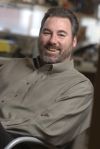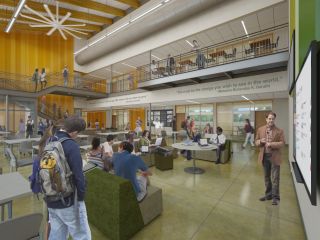|
Subscribe / Renew |
|
|
Contact Us |
|
| ► Subscribe to our Free Weekly Newsletter | |
| home | Welcome, sign in or click here to subscribe. | login |
Architecture & Engineering
| |
 |
June 27, 2013
When a new school is the only game in town

By MICHAEL McGAVOCK
McGranahan Architects |
When designing a new high school how do you determine the “right” vision for the future of education in your community? How does a small community take a chance on any particular vision when they only have one high school to “experiment” with?
That was the challenge Woodland School District in Cowlitz County faced when they chose to replace their high school. As they say, it’s the “only game in town.”
What the future holds
There are many visions for the future of education. Some emphasize online learning while others feature science, technology, engineering and math (STEM). Programs that accentuate project-based learning and demonstration of proficiency also have supporters.
Fostering creativity and innovation are hallmarks of some models and many call for a greater connection between community resources and the amenities within the school. Some models claim to look out to the year 2020, others to 2025. The fact is, we are already planning schools that will be a few years old when that future arrives, and the buildings will last decades past those milestones.
There are some common characteristics of learning environments among the themes listed above. In addition to mastery of content, there is a focus on developing skills related to inquiry, creativity, teamwork and problem solving.
The models call for more collaboration among peers and working in teams. Less time during the school day is spent on the delivery of curriculum content, and more on the retrieval of relevant information to solve problems related to the curriculum.
There is less reliance on seminar (classroom) type spaces for learning activities, which has been the dominant mode of teaching and learning for over a century. Teachers guide students’ discovery through work on meaningful projects that address real-world concerns, globally and in the local community.
Information is “at hand” through personal, mobile technology and ubiquitous Internet access. Students are challenged in their individual strengths and supported in areas they are weak. There is a sense of belonging to a community and a responsibility to contribute to it.
Are we any closer to that vision in the learning environments we are creating today? There are some examples to draw from.
Schools that embody some of these characteristics have generally been specialized and given license to experiment. Examples include High Tech High in San Diego, with an interdisciplinary focus, or skills centers, which offer more hands-on learning related to particular career paths, or more recently, STEM schools that focus on problem-based learning.
Each of these examples has an intentionally narrow focus. How can we take lessons from these models and create a high school that embodies these characteristics in a singular facility for all of the students in a community?
Flexible spaces
What if the core organization of the school and its culture was more about the acquisition of skills for inquiry, innovation and problem solving, and less about delivery of content?
Educational systems are moving from delivery of curriculum content to ensuring students also acquire skills for lifelong learning. Students engage with curriculum content in the course of their work on projects. They remember the lessons better because they are doing something meaningful with it. How can the school setting foster that approach?
Learning skills through creative endeavors, teamwork and problem-solving require a variety of settings to support the learning activities. There has been much discussion about what needs to change within classrooms to provide more engagement.
What about the other settings in the school, such as labs, studios and fabrication spaces? How can they be arranged to create a more integrated and creative learning environment? Getting the right spaces together to create a more diverse composition of learning activities is a first step.
A grouping of diverse settings for curriculum areas like math, science, humanities, arts and fabrication supports diverse learning activities. Many of these activities are accomplished with digital resources, including computer-aided design and modeling, science simulation or digital media production. Studios with versatile computers are essential elements that are shared for a variety of learning activities.
The composition should also include flexible, open space at the center for collaboration, demonstration and presentation, for problem-solving or sharing of knowledge produced. The collected settings should be apparent and available to students for the different aspects of problem solving: inquiry, design, prototyping, testing and validation.
Collecting spaces that support diverse disciplines makes it easier to make relationships between activities that foster innovation and problem-solving skills. It also brings together teachers who can be advisors in a close-knit setting to challenge students and guide their progress.
Teachers can collaborate within and across disciplines. Students have a variety of resources easily available to them. Can this be accomplished in the design of a singular high school, built with a common vision to serve all the students in the community?
Balancing new and old
Woodland School District serves a community surrounded by farmland, industry and high tech. Many students desire careers in their home community, others aspire for a different path beyond the local environs. Their new high school is designed to support anticipated growth from 700 to 900 students.
Because it is the only high school in town, it needs to support some degree of traditional comprehensive curriculum delivery when it opens in 2015 as well as the changes envisioned in 2025 and beyond.
Woodland High School is designed around the spaces and relationships described above. All of the traditional spaces included in a high school are there, just arranged together with different relationships.
The community made an intentional investment to include shared activity settings that support the new arrangement. The school includes two large groups of diverse settings, arranged on two floors.
Within each group there are close connections between classrooms, labs, hands-on studios and fabrication/performance spaces that support the diverse activities of creative, problem-based learning.
At the center of these specialized spaces is an open shared area for meetings, small group work, lectures, exhibits and presentations. Collaboration and a sense of community among students and teachers is fostered with visual connections between rooms and openness between floors.
When it opens in 2015, the new high school will be a reinvigorated center of the Woodland community, with new centers of learning for students who are gaining skills to be prepared for their diverse futures.
Michael McGavock is a principal at McGranahan Architects. His focus is planning and design for education.
Other Stories:
- Safer schools start with design, not security
- A school designed for K-12 and beyond
- There's no one way to keep kids safe
- Classrooms are out, learning studios are in
- Skateboards move supplies in Chief Sealth rehab
- Successful projects reflect what voters want
- Theater technology: latest may not be greatest
- ‘Green dashboards’ help students learn to save energy



